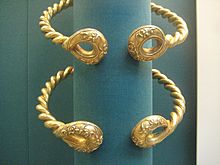Ipswich Hoard facts for kids
Quick facts for kids Ipswich Hoard |
|
|---|---|

Two of the torcs
|
|
| Discovered | in Ipswich |
| Present location | British Museum, London |
The Ipswich Hoard actually refers to two amazing discoveries made in Ipswich, England. One was a collection of Anglo-Saxon coins found in 1863. The other, found in 1968 and 1969, was a treasure of six Iron Age gold torcs (fancy neck rings). This second hoard is super important, almost as famous as the Snettisham Hoard, and you can see it at the British Museum in London.
Contents
The First Ipswich Hoard (1863)
The first Ipswich Hoard was found in 1863. It was hidden in an earthenware pot. The pot was buried about 3 meters (10 feet) deep. It was found under the doorstep of a house in Ipswich.
This house was being torn down to make way for a wider road. The hoard contained about 150 silver pennies. These coins were from the time of King Æthelred the Unready. They were made in London and Ipswich. Experts think the coins were buried between 979 and 985 AD.
The Second Ipswich Hoard (1968-1969)
The second Ipswich Hoard is much more famous. It consists of six beautiful gold neck rings called torcs. These torcs are from the Iron Age.
How the Gold Torcs Were Found
In 1968, a digger operator was preparing land for new houses near Ipswich. He accidentally uncovered five of these amazing gold torcs. For his discovery, the driver received £45,000!
A year later, the sixth torc was found. The owner of one of the new houses found it. He was sorting through a pile of earth in his garden. He received £9,000 for his find.
What the Gold Torcs Look Like
These torcs are made from a special type of gold called "green gold." This means it has less silver than other gold. Experts at the British Museum believe they were made around 75 BC.
Each torc was made by twisting two thick gold wires together. They were then shaped into a circle. The ends of the torcs have special decorations called "terminals." These terminals were made using a method called the "lost wax process."
Making the Torc Terminals
The "lost wax process" is a clever way to make detailed metal objects. First, the artist creates the design for the terminal in wax. Then, the wax model is covered in a special ceramic liquid. This liquid hardens into a mold.
Next, the mold is heated. The wax inside melts and drains away, leaving a hollow space. Finally, melted gold is poured into this empty space. Once the gold cools, the ceramic mold is broken away. This leaves a detailed, hollow gold terminal. Each torc has slightly different designs on its left and right terminals.
The museum estimates that these torcs could fit necks up to about 18.7 cm (7.4 inches) wide.
Where to See the Ipswich Hoard Today
The gold torcs found in 1968 are on display in Room 50 of the British Museum in London. You can also see copies of these amazing torcs at the Ipswich Museum.


